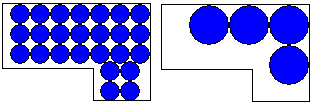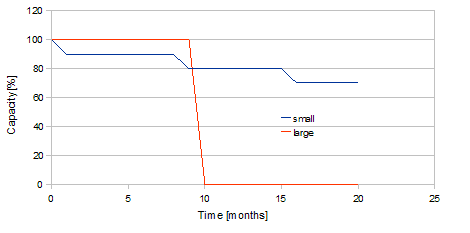 Li-Ion BMS
Li-Ion BMS
|
Home White Paper - Lots of small cells are better than one big one Reliability, energy density and thermal performance are improved by using many small cells in parallel 
Question: At first look, that choice would appear to be a no brainer: welding 10 cells in parallel requires more effort, and the likelihood of a bad or broken weld among those 20 connections is a concern.
Actually, there are significant advantages in using many cells in parallel.
Space utilization. 
In a theoretical, circumscribed space, small cells (left) use space just as efficiently as large ones (right). In reality, the space available for a battery pack is unlikely to exactly circumscribe the large-format cell, and the space may not even be rectangular. Therefore, in reality you can pack many more small cells in the available space, than you can a few large-format cells. This is less of a concern for products designed from the ground up to use large format cells (e.g.: the GM Volt), but it can make a significant difference when a battery must be retrofit in a space carved out of an already designed product (e.g.: a PHEV conversion). 
In practice, small cells (left) fit better than large ones (right).
Reliability. Let's say that we have a choice between using small, 1 Ah cells, or large, 10 Ah cells. Cells are of the same chemistry and have the same MTBF. Let's also say that, over a month, cells of either size have a 1 % likelihood of suddenly losing capacity (whether because of internal cell failure or because of external wiring failure). Compare the effect of that on two packs with 10 cells in series. One pack uses 10 small cells in parallel (10S10P), the other pack uses a single string of large cells (10S1P). Statistically, after 10 months, the pack with small cells will have lost 20 % of its capacity. But the pack with large cells will have lost all of its capacity. The user of the small-cell pack may not even notice that the pack has lost some capacity. But the user of a large cell pack will certainly notice the complete loss of capacity. 
Statistical 10% loss of cells in a small cell pack result in a 20% loss in capacity (left). In a single-string, large cell pack, it results in a 100 % loss (right). From a service stand point, it is better to build a pack with small cells, with an extra 20 % capacity, so that, even after losing some cells, the pack will still meets its specifications, and will not require service. 
Pack capacity plot as cells are lost for a small cell pack (left) and a large cell pack (right). Of course, sudden capacity loss is not the only failure mechanism. For other mechanism (gradual capacity loss, shorted cell), using small cells offers no particular advantage.
Thermal performance. 
Thermal gradients in a small cell pack (left) and a large cell pack (right).
Counter argument.
Davide Andrea, Elithion, 9/18/08 | ||
© 2008~2025 Davide Andrea. All rights reserved, except where noted by CC mark. Page published on Aug 01 2009. Graphic design by morninglori